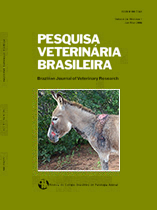 |
|
|
|
Year 2014 - Volume 34, Number 12
|

|
Phylogenetic analysis of rabies virus isolated from herbivores in Minas Gerais and São Paulo border (2000-2009), Brazil, 34(12):1196-1202
|
ABSTRACT.- Estévez Garcia A.I., Peixoto H.C., Silva S.O., Polo G., Alves A.J., Brandão P.E., Cunha E.M. & Richtzenhain L.J. 2014. Phylogenetic analysis of rabies virus isolated from herbivores in Minas Gerais and São Paulo border (2000-2009), Brazil. Pesquisa Veterinária Brasileira 34(12):1196-1202. Departamento de Medicina Veterinária Preventiva e Saúde Animal, Faculdade de Veterinária e Zootecnia, Universidade de São Paulo, Av. Prof. Dr. Orlando Marques de Paiva 87, Cidade Universitária, São Paulo, SP 05508-270, Brazil. E-mail: isaestgar@yahoo.com
Rabies transmitted by the hematophagous bat Desmodus rotundus represents a public health concern and a burden for the Brazilian livestock industry. Current evidence suggests that rabies occurrence is related to landscape characteristics, topography, hydrography, animal production systems and land use. However, a few studies have analyzed the possible connections among geographic factors and the molecular diversity of the rabies virus, furthering the understanding of the spatial and temporal dynamics of outbreaks. A study reported that the latest rabies epizootics in herbivores reported in the eastern region of São Paulo (close to the Minas Gerais border) occurred in two epidemic waves; the first was before 1998, and the other occurred after 1999. Using this evidence, the aim of the present study was to analyze cases of rabies in herbivores in the southern region of Minas Gerais (2000-2009) and their possible relationship with the aforementioned epidemics, considering the geographic characteristics of the region. Partial sequences of glycoprotein (539 nt) and nucleoprotein genes (414 nt) were obtained from 31 rabies virus isolates from herbivores. A phylogenetic tree was proposed for each genomic region using the Neighbor joining method, fixing the Kimura 2-parameter evolution model with a bootstrap level of 1,000 replications. Genetic sublineages were plotted on maps, considering rabies risk areas for herbivores in São Paulo, as well as topographic characteristics and hydrographic basins, to visualize any apparent distribution pattern influenced by those features. The phylogenetic trees had concordant topologies, suggesting a possible common origin for rabies outbreaks in herbivores along the SP/MG border, surrounding the less elevated portions of the Serra da Mantiqueira and along the hydrographic basins of Piracicaba/Jaguarí, Paranaíba do Sul, Grande, Pardo and Mogi-Guaçu rivers.The co-circulation of several viral lineages was observed in some municipalities, possibly due to an overlapping of rabies outbreaks. Inferred protein sequences of both genes showed synonymous mutations, except among residues 20 to 200, corresponding to the external domain of the glycoprotein. This information prompted cooperation among the animal health services of both states to reinforce rabies control in the border area. |
| |
|
|
| |
|
 |